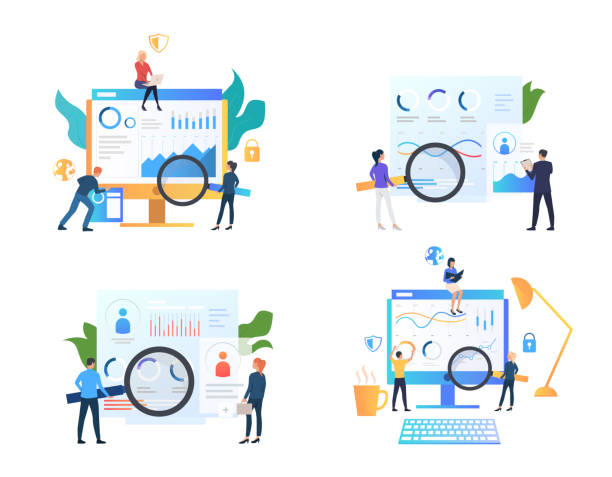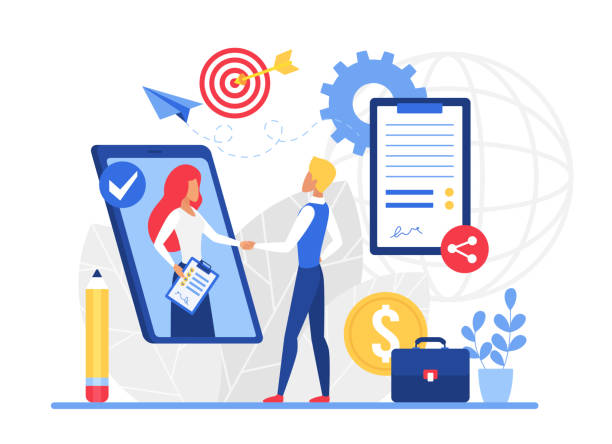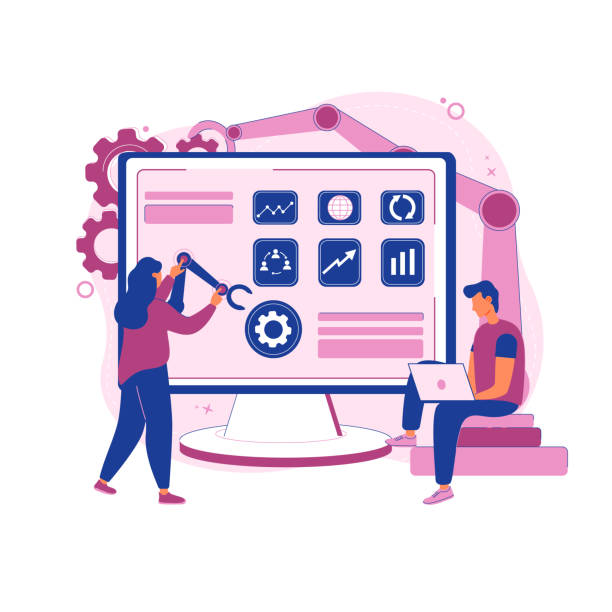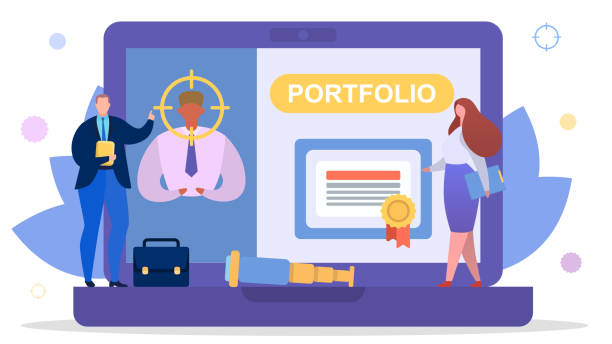Introduction to Fast Website Design and its Importance in the Current Era

In today’s digital world where speed is paramount, #FastWebsiteDesign is not just a competitive advantage, but has become a necessity.
Users expect websites to load in a fraction of a second, otherwise, they quickly leave and go to the next competitor.
This is crucial, especially for businesses looking to attract and retain customers.
Website speed directly affects user experience, conversion rates, and even your ranking in search engines.
A fast-loading website allows visitors to access their desired content without any delay, which leads to greater satisfaction and their likelihood of returning.
Search engines like Google also place special importance on site speed, considering it one of the key factors in ranking web pages.
Therefore, if you are looking to improve SEO and gain more visibility in search results, website speed optimization is an essential step.
This includes optimizing images, using caching, compressing files, and choosing suitable hosting.
Achieving fast website design requires a comprehensive approach and attention to technical details.
Further in this article, we will delve deeper into these topics and provide practical solutions to achieve the highest possible speed for your website.
The importance of this issue is such that even large companies invest heavily in this area to ensure their users have the best possible experience.
Losing customers because of your online store’s outdated appearance or slow speed bothers you?
Rasaweb’s expert team solves these problems with professional online store design!
✅ Increase customer trust and brand credibility
✅ Stunning speed and excellent user experience
Get a free consultation with Rasaweb right now ⚡
Benefits of High Speed for Users and Search Engine Optimization

#HighWebsiteSpeed not only keeps users satisfied but also has a tremendous impact on your website’s #SEO.
From a user’s perspective, nothing is more frustrating than waiting for a page to load.
Studies have shown that users abandon a website if it doesn’t load within 3 seconds.
This early exit, known as “Bounce Rate”, sends a negative signal to search engines.
On the other hand, a fast website leads to a better user experience, and users spend more time on your site, view more pages, and the likelihood of taking actions like purchasing or filling out contact forms increases.
These positive interactions signal to search engines like Google that your content is valuable.
In terms of SEO, Google has explicitly stated that page load speed is a ranking factor.
Websites that load faster have a greater chance of achieving higher rankings in search results.
This became even more prominent with Google’s introduction of Core Web Vitals, which provide tangible metrics for evaluating user experience based on speed.
Therefore, fast website design directly translates to improved visibility, increased organic traffic, and ultimately, your business growth.
Digital marketing teams and web developers should always pay attention to this aspect of site performance to stay ahead of their competitors.
Continuous speed optimization is considered a smart investment for any brand’s digital future.
Key Factors Affecting Website Speed and Specialized Solutions

Achieving #OptimalSpeed for a website requires a precise understanding of the factors that influence it.
Among the most important of these factors are #WebHosting, #ImageSize, #OptimizedCode, and the use of #ContentManagementSystems.
One of the first steps in the fast website design process is choosing a high-quality and high-speed hosting server.
A slow server can render your optimization efforts ineffective.
Using images with inappropriate sizes and formats is another common factor in speed reduction.
Images should be optimized, compressed, and saved in modern formats like WebP.
Website coding also plays a vital role; heavy and unoptimized CSS and JavaScript codes can severely slow down page loading.
Minification and concatenation of these files can lead to significant improvements.
Furthermore, while content management systems like WordPress offer great flexibility, improper use of heavy plugins and themes can harm website speed.
Here is a comparative table of important factors and their impact on website speed:
| Factor | Explanation | Impact on Speed |
|---|---|---|
| Web Hosting | Server quality and its location relative to users | Very High |
| Images | Size, format, and compression of images | High |
| CSS and JavaScript Code | Volume, number of files, and compression | High |
| Caching | Temporary storage of data for faster loading | High |
| Plugins and External Scripts | Number and quality of plugins and third-party scripts | Medium |
To optimize these factors, using tools like Google PageSpeed Insights and GTmetrix is essential to identify website weaknesses.
Fast website design is a continuous process that requires ongoing monitoring and optimization.
New Tools and Techniques for Speed Optimization

On the path to #WebsiteSpeedOptimization, using new tools and techniques can make a significant difference.
Among the most important of these techniques are #AdvancedCaching, #GzipCompression, #CDNUsage, and #LazyLoading.
Caching or temporary data storage is one of the most powerful methods for improving load speed.
By enabling caching, the user’s browser can store a copy of the site’s pages and resources, so on subsequent visits, there is no need to re-download all content, and the page loads much faster.
Tools like WP Rocket for WordPress or Varnish Cache for servers are very effective in this regard.
The Gzip compression technique also significantly reduces data transfer time by decreasing the size of HTML, CSS, and JavaScript files, thereby enabling fast website design.
Content Delivery Network (CDN) is also an excellent solution for websites with global audiences.
A CDN delivers content from the closest server to the user by storing copies of your website’s content on multiple, globally distributed servers, which minimizes physical distance and consequently latency.
This technology is especially vital for large websites with high traffic.
Lazy Loading is a technique that loads images and videos only when they are within the user’s viewport, instead of downloading all of them at the initial page load.
This significantly increases the initial load speed, especially for long pages with a lot of visual content.
Combining these tools and techniques can create a huge leap in your website’s performance and help you stay ahead in the digital competition.
Persistence in using these methods ensures your website’s high speed in the long run.
Does your current online store design not generate the expected sales for you?
Rasaweb specializes in professional online store design!
✅ An attractive and user-friendly site with the goal of increasing sales
✅ High speed and security for an ideal shopping experience⚡ Get a free online store design consultation with Rasaweb!
The Importance of Responsive Design and Mobile Speed in Fast Website Design

In the current era, where the majority of internet traffic comes from mobile devices, #ResponsiveDesign and #MobileSpeed have become two fundamental pillars in #FastWebsiteDesign.
#MobileFirstImportance extends beyond merely displaying the website correctly on different screen sizes; it also includes optimizing performance and loading speed for mobile devices.
A website that is fast on desktop will not necessarily be fast on mobile, as network conditions and processing power of mobile devices differ.
Therefore, attention to mobile user experience is of high importance.
Google has clearly stated that it ranks pages based on the mobile version of websites (Mobile-First Indexing).
This means that if your site’s mobile version is slow, regardless of how fast its desktop version is, your SEO ranking will suffer.
To achieve high web speed on mobile, in addition to general speed optimization solutions (such as image and code compression), specific mobile details must also be considered.
These details include optimizing fonts for mobile display, reducing HTTP requests, using Accelerated Mobile Pages (AMP) for news and blog content, and ensuring all interactive elements function correctly and without delay on touch devices.
Fast website design for mobile not only helps improve your Google ranking but also significantly enhances the user experience for millions of people who connect to the internet via their smartphones.
This approach allows you to attract a wider audience and improve your conversion rates across all platforms.
The Role of Hosting in Site Performance: Choosing the Best Service

Choosing #SuitableHosting is one of the most important decisions in the #FastWebsiteDesign process that is often overlooked.
Even with the best client-side optimizations, a #WeakHosting can render all efforts fruitless.
Server response time (Time To First Byte – TTFB), which indicates the time required to receive the first byte of data from the server, has a direct impact on the overall site loading speed.
Different types of hosting such as shared hosting, VPS (Virtual Private Server), and dedicated server each have their own specific features and limitations.
Shared hosting is usually the cheapest option, but server resources are shared among multiple websites, which can lead to slow performance during peak hours.
This type of hosting is suitable for small websites with low traffic.
VPS is a mid-range option that gives you more dedicated resources and greater control over the server environment.
This option is ideal for websites with moderate and growing traffic.
A dedicated server is the most expensive option, but all server resources are allocated to your website, offering the highest speed and security.
This option is recommended for large websites with very high traffic.
In addition to the type of hosting, factors such as server location (the closer to your target users, the better), technical support, and the type of hard disk (SSD instead of HDD) also affect speed.
Choosing a hosting provider that supports modern technologies like HTTP/2 and PHP 7.x is also crucial.
Fast website design will be difficult, if not impossible, without a strong hosting infrastructure.
Therefore, before or even after launching, a thorough evaluation and investment in a reputable hosting service is a vital step towards ensuring your website’s optimal performance.
Common Mistakes in Speed Optimization and Ways to Avoid Them

On the path to #WebsiteSpeedOptimization, many designers and developers encounter common mistakes that can render their efforts for #FastWebsiteDesign ineffective.
Understanding these mistakes and knowing how to avoid them is key to achieving optimal performance.
One of the biggest mistakes is #NeglectingImageOptimization.
Using high-resolution and large-sized images without proper compression can severely reduce loading speed.
The solution is to always compress images before uploading and use modern formats like WebP.
Another common mistake is #InstallingTooManyUnnecessaryPlugins, especially in content management systems like WordPress.
Every plugin adds extra code to the site, which can lead to reduced speed.
It is recommended to use only essential and reputable plugins and to remove inactive or old ones.
Also, #LackOfProperCaching can significantly impact speed.
Some sites have no caching mechanism, while others use incorrect settings.
Implementing a powerful caching solution and configuring it correctly is essential.
| Common Mistake | Explanation | Solution |
|---|---|---|
| Unoptimized Images | Using images with high volume and dimensions | Compression, format conversion, Lazy Loading |
| Too many and low-quality plugins | Adding functionalities with heavy plugins | Careful plugin selection, removal of unnecessary ones |
| Lack of Caching | Full site loading on every visit | Installation and configuration of caching plugins |
| Lack of Code Compression | Large size of CSS and JS files | Minification and Gzip compression |
| Inappropriate Hosting | Choosing a low-quality or cheap hosting service | Investing in powerful hosting |
Furthermore, lack of CSS and JavaScript file compression or failure to enable Gzip compression on the server can also lead to site slowness.
By understanding these challenges and implementing appropriate solutions, you can have a website with excellent performance and fast loading that both satisfies users and improves your SEO ranking.
Future Trends in Website Performance and Preparing for Them

The web world is constantly changing, and #FutureTrends in #WebsitePerformance are no exception.
Awareness of these trends and preparation for them are crucial for anyone who values #FastWebsiteDesign.
One of the most important recent developments is Google’s focus on #Core_Web_Vitals.
This is a set of user experience metrics including LCP (Largest Contentful Paint), FID (First Input Delay), and CLS (Cumulative Layout Shift) which, respectively, measure the loading speed of the main content, website responsiveness to user interactions, and visual stability.
These metrics are not only important for SEO but also reflect the actual user experience.
New technologies such as HTTP/3 and WebAssembly are also emerging, promising new leaps in web speed and performance.
HTTP/3 is the next generation of the HTTP protocol, built on QUIC, and aims to reduce latency and improve performance on unstable networks.
WebAssembly also allows developers to execute high-performance code directly in the browser, which can be very useful for complex applications and web-based games.
Increased use of Artificial Intelligence and Machine Learning in website optimization, such as pre-loading content based on user behavior or automatic image optimization, is also expected to become more common in the near future.
Preparing a website for these trends involves updating server infrastructures, using the latest versions of protocols and software libraries, and continuously implementing best optimization practices.
Websites that keep pace with these developments will not only be technically stronger in the future but will also deliver an unparalleled user experience.
Does your current online store design cause you to lose customers and sales?
Rasaweb is your solution with modern and user-friendly online store designs!
✅ Significant increase in conversion rates and sales
✅ Building strong branding and gaining customer trust
⚡ Get a free online store design consultation from Rasaweb!
Case Studies and Success Stories in Achieving High Speed

Nothing illustrates the importance of #FastWebsiteDesign as much as observing #RealCaseStudies and #SuccessStories.
These cases demonstrate how website speed optimization can directly impact #BusinessSuccess.
For instance, a major online retail company managed to increase its conversion rate by 8% by reducing its page load time by just 0.1 seconds.
This seemingly small improvement resulted in millions of dollars in additional revenue.
This example clearly shows that even minor changes in website speed can have immense financial impacts.
Another example was a media company’s website that faced severe slowness due to increased traffic.
By implementing a powerful CDN, optimizing images, and server-side codes, they were able to reduce their page load time by up to 50%.
The result was a significant increase in Page Views and a reduction in bounce rate.
These changes not only led to an improved user experience but also prompted Google to rank this website higher due to its better performance, significantly increasing its organic traffic.
These stories are not just about SEO improvement; they represent a strategic investment in digital infrastructure that directly leads to increased customer satisfaction, brand loyalty, and ultimately, revenue growth.
Companies committed to continuous website speed optimization will not only be technically advanced but can also gain a sustainable competitive advantage in the highly competitive digital market.
These examples provide greater motivation for any business to approach the topic of fast website design with more seriousness.
The Importance of Continuous Updates and Site Maintenance for Speed Preservation

#ContinuousUpdates and #SiteMaintenance play a vital role in #PreservingYourWebsiteSpeed.
#FastWebsiteDesign is not a one-time process, but requires continuous attention and optimization.
Server-side software (like PHP and databases), Content Management Systems (CMS), and all plugins and themes used must be regularly updated.
These updates not only include security improvements but often also contain performance optimizations that can increase your site’s speed.
Neglecting these updates can lead to security vulnerabilities and a gradual decrease in site speed.
In addition to software updates, #DatabaseMaintenance is also of high importance.
Over time, the website database may become filled with unnecessary and irrelevant information, which can reduce data retrieval speed.
Regular database optimization and cleanup can help improve overall site performance.
Also, #ContinuousMonitoring of site performance using tools like Google PageSpeed Insights and Google Analytics is essential.
These tools help you quickly detect any speed drops and resolve them before they negatively impact user experience.
#RegularWebsiteBackup is also vital in the maintenance process.
This ensures that in case of any serious issues, you can quickly restore the site to its previous state and prevent data loss.
Finally, paying attention to these aspects is crucial to ensure that your efforts for fast website design remain sustainable and effective.
Frequently Asked Questions
| Row | Question | Answer |
|---|---|---|
| 1 | What does fast website design mean? | Fast website design refers to optimizing the website design and development processes so that the final result (the website) is ready for operation in the shortest possible time, while maintaining quality and efficiency. This includes using efficient tools, templates, and techniques. |
| 2 | Why is speed important in website design? | Speed in website design is important because clients typically have an urgent need for an online presence. Also, longer projects can be more costly and delay business opportunities. Faster website delivery contributes to customer satisfaction and competitive advantage. |
| 3 | What tools help with fast website design? | Content Management Systems (CMS) like WordPress, Joomla, or Drupal; the use of CSS frameworks like Bootstrap or Tailwind CSS; Page Builders like Elementor or Visual Composer; and Rapid Application Development (RAD) tools help with fast design. |
| 4 | Does using pre-made templates affect fast design? | Yes, using pre-made and standard templates has a significant impact on fast design. These templates are pre-designed and only require content, color scheme, and image customization, which drastically reduces development time. |
| 5 | What is the role of CMS (Content Management System) in fast website design? | CMSs play a key role in accelerating the website design and development process due to their graphical user interface, no need for deep coding for most operations, availability of ready-made plugins and templates, and easy content editing capabilities. |
| 6 | Does high design speed reduce the final quality of the website? | Not necessarily. If standard and optimized methods, tools, and templates are used, a high-quality website can be designed in a short time. The knowledge and experience of the design team are also very effective in maintaining quality. |
| 7 | What tips are important for accelerating the client communication process in website design? | Having a clear and defined process for gathering requirements, using standard forms for content submission, setting realistic deadlines, and holding focused and efficient meetings can accelerate client communication. |
| 8 | What is the effect of image optimization on website loading speed after design? | Image optimization (volume compression, use of suitable formats like WebP) reduces the overall size of website pages. This reduction in size helps browsers download and display pages faster, which improves user experience. |
| 9 | Is suitable hosting effective in the final speed of the website after design? | Yes, high-quality hosting, powerful servers, sufficient resources, and adequate bandwidth play a very important role in website loading speed after design. Even an optimized website will perform slowly on weak hosting. |
| 10 | For what types of businesses is fast website design most suitable? | Fast website design is highly suitable for small and medium-sized businesses, startups, nascent online stores, bloggers, or individuals who need an immediate and low-cost online presence. This method allows them to enter the market faster and receive feedback. |
And other services of Rasaweb Advertising Agency in the field of advertising:
Smart Data Analysis: An effective tool for customer acquisition through marketing automation.
Smart UI/UX: Professional optimization for campaign management using real data.
Smart Link Building: Professional optimization to increase site visits using intelligent data analysis.
Smart Custom Software: A combination of creativity and technology for analyzing customer behavior through user experience customization.
Smart Data Analysis: Transform online growth with the help of intelligent data analysis.
And over a hundred other services in the field of internet advertising, advertising consultation, and organizational solutions.
Internet Advertising | Advertising Strategy | Advertorial
Sources
The importance of site speed in digital success
Key tips for fast website design
Website speed optimization and SEO
Hidden secrets of successful websites
? For a powerful and lasting presence in the digital space, Rasaweb Afarin Digital Marketing Agency is your constant companion, offering innovative solutions including fast website design and professional services.
📍 Tehran, Mirdamad Street, Next to Central Bank, Southern Kazerun Alley, Ramin Alley No. 6

